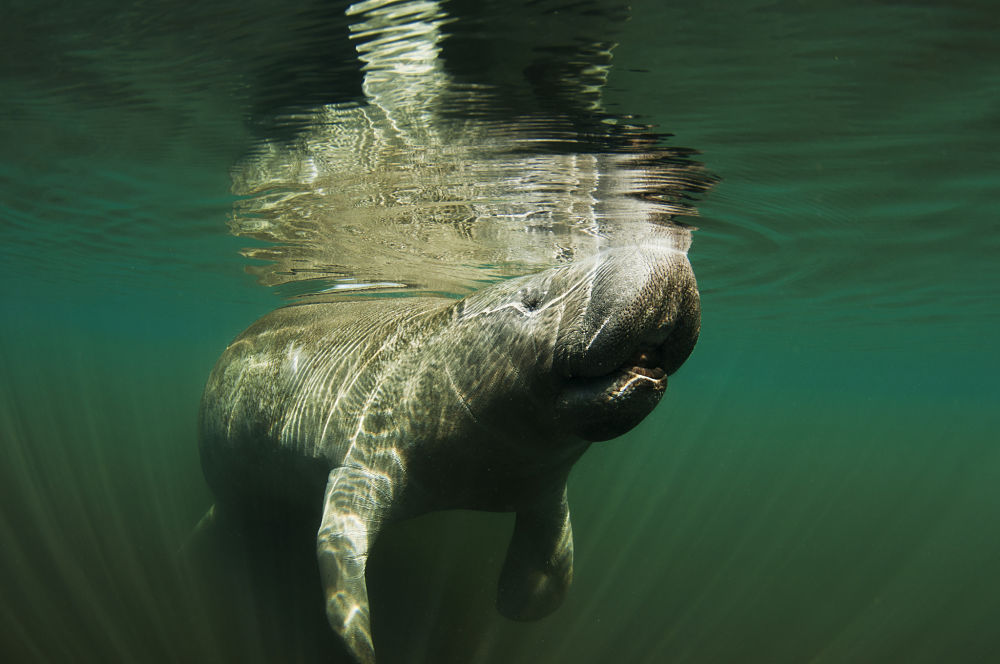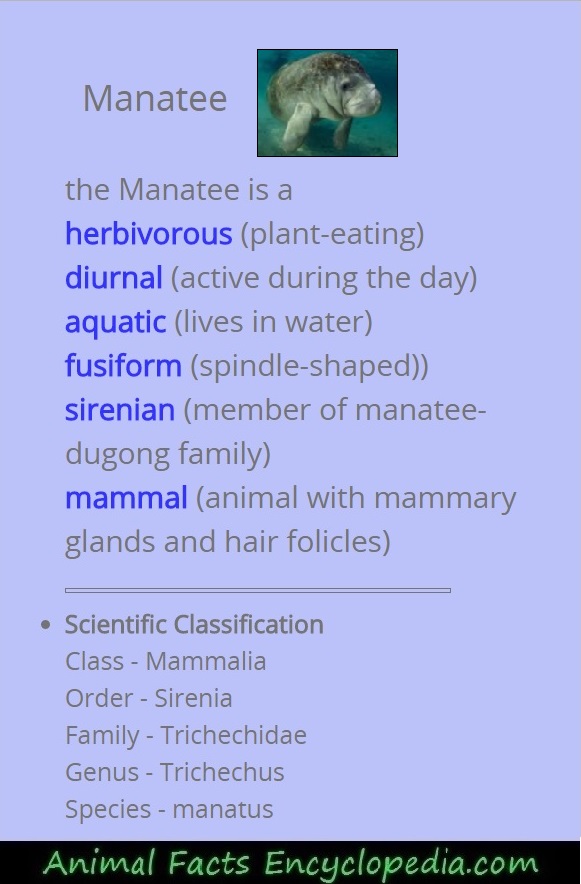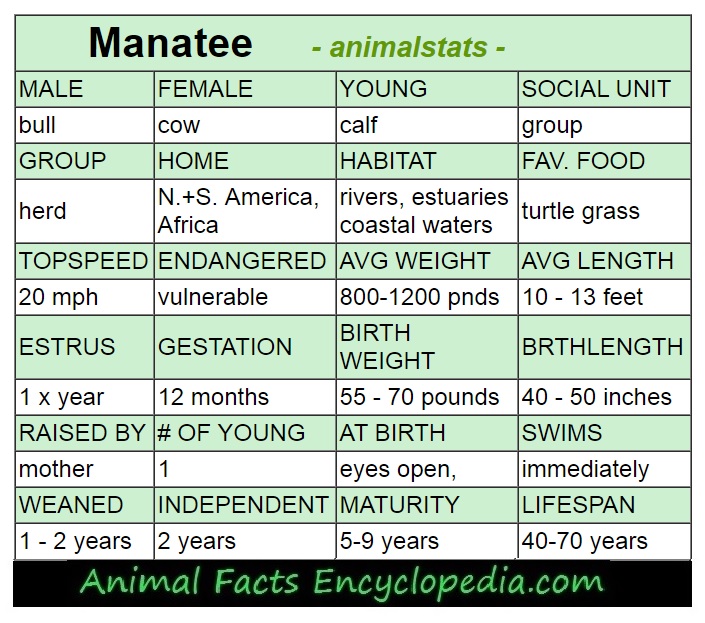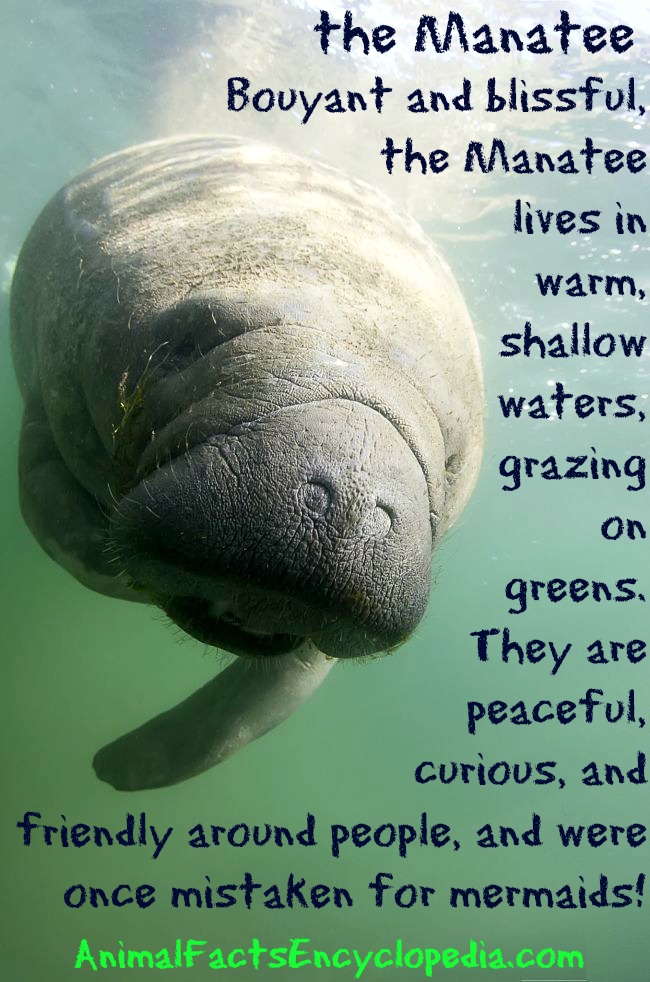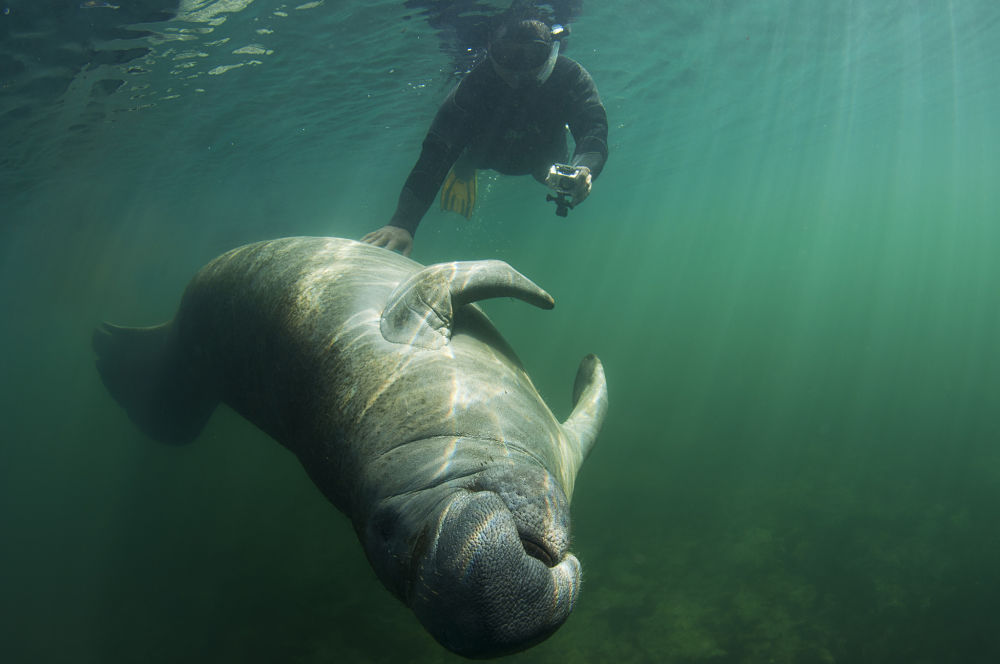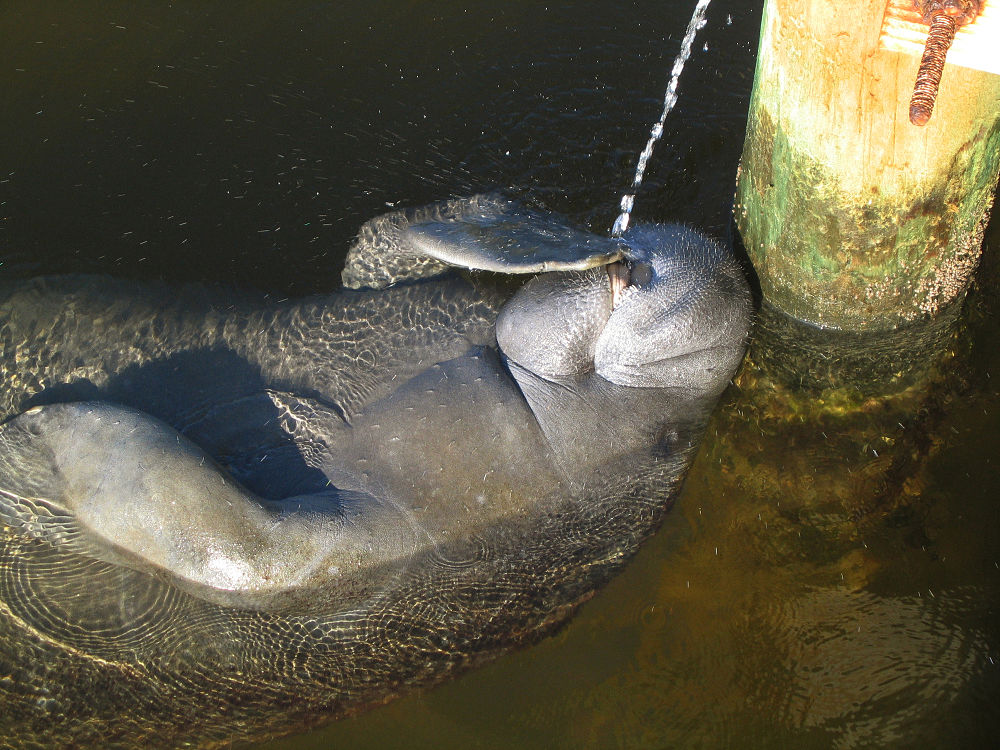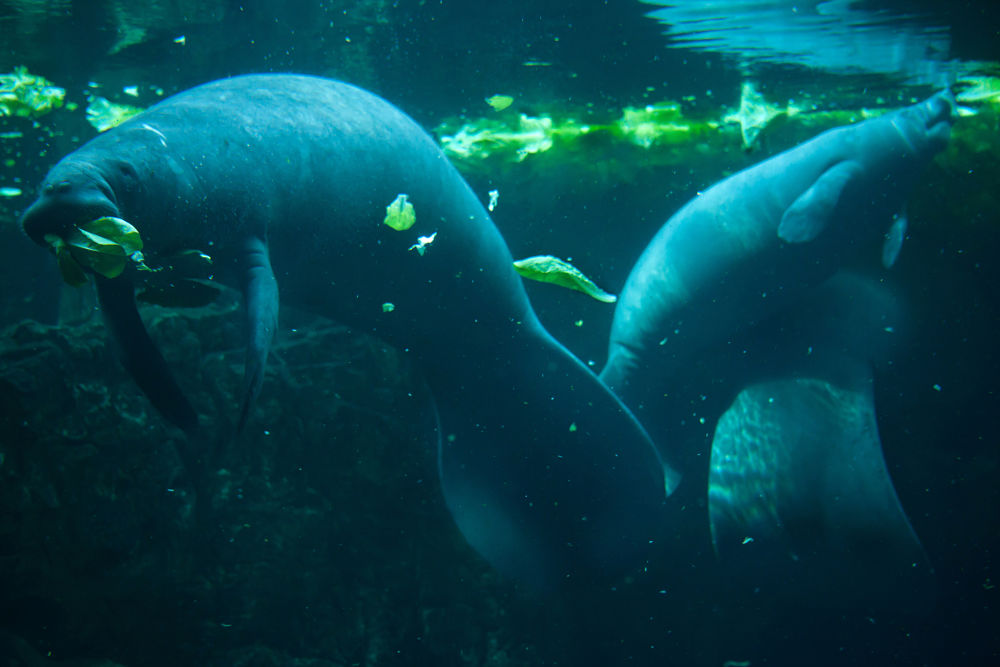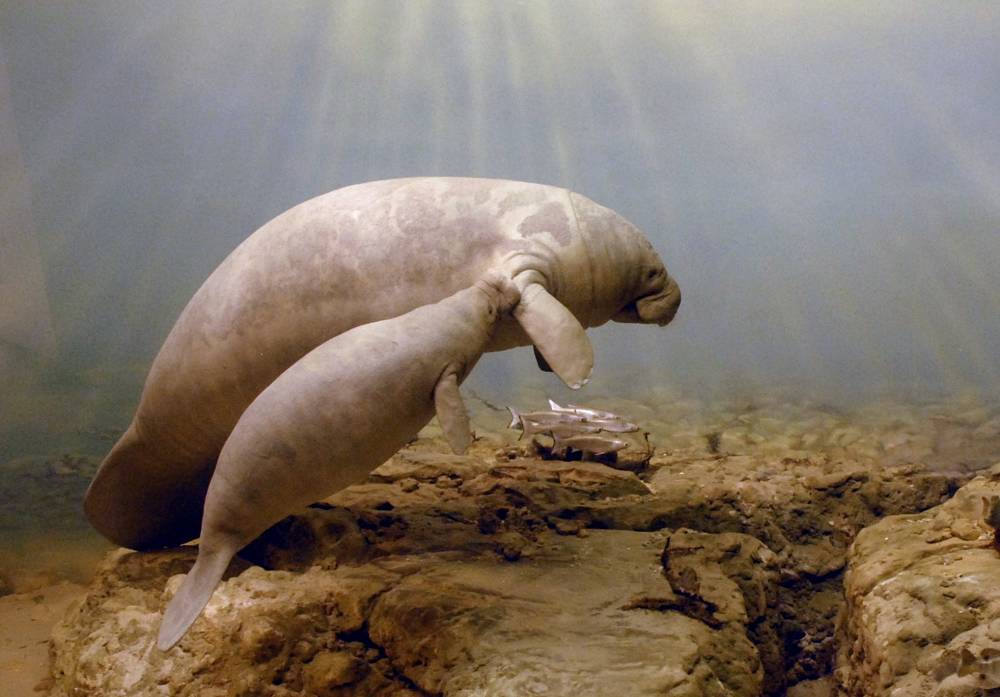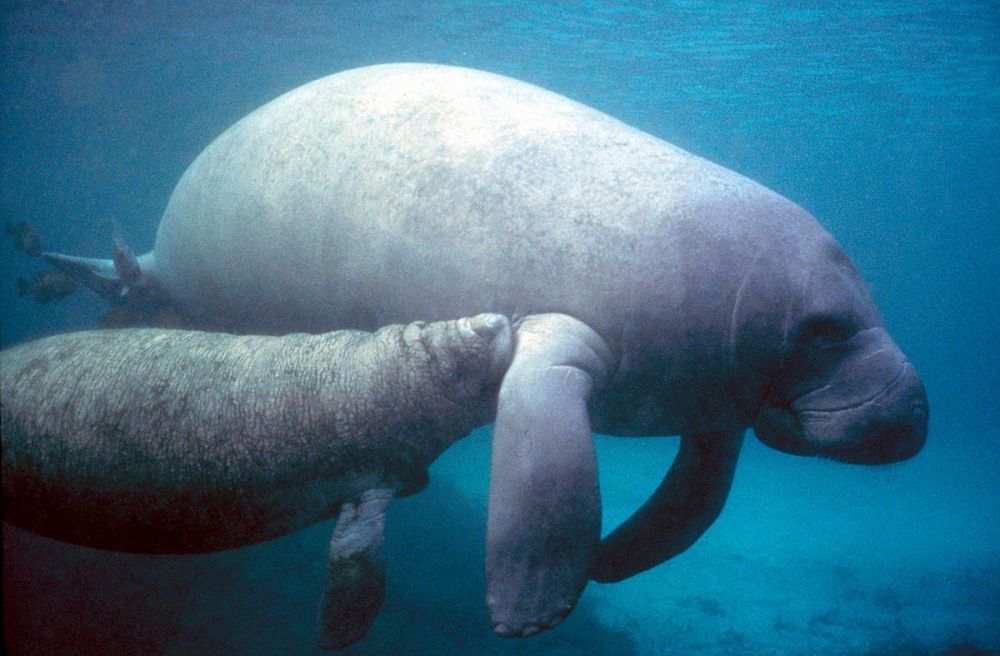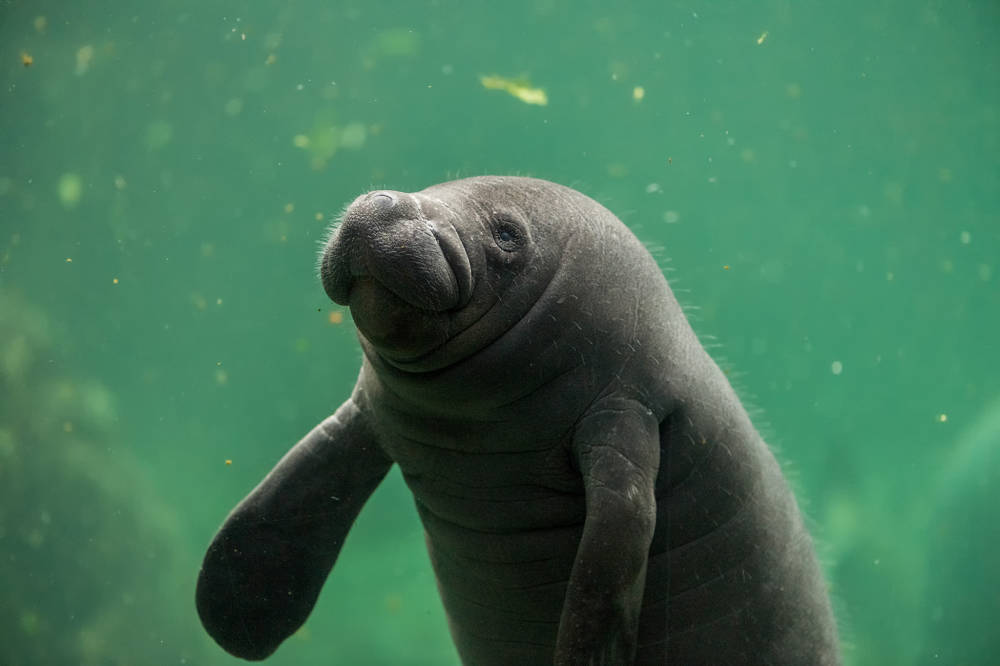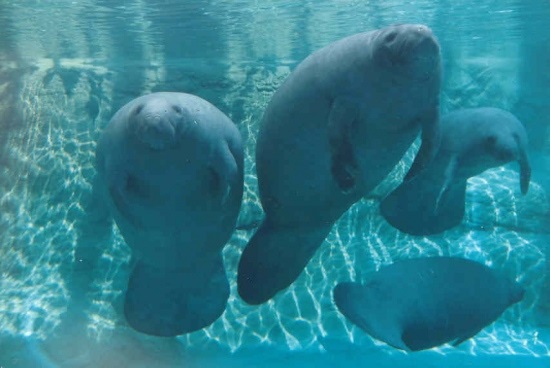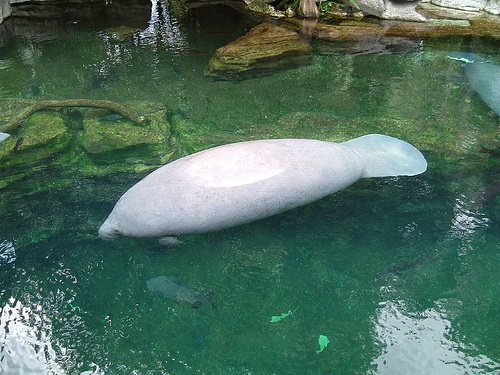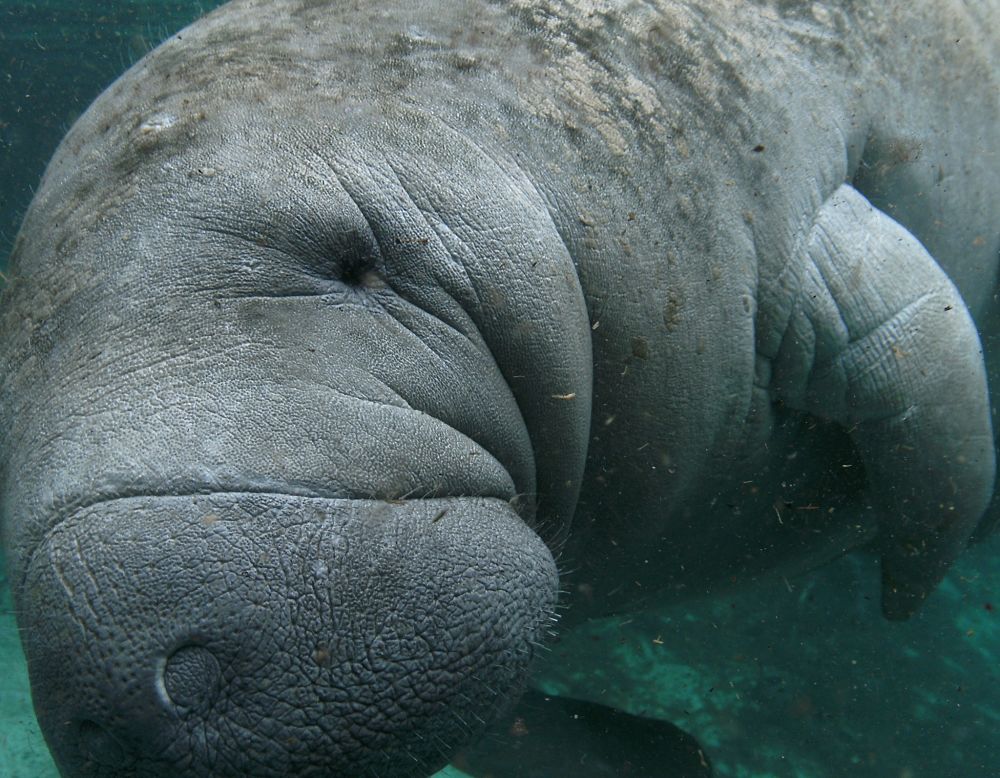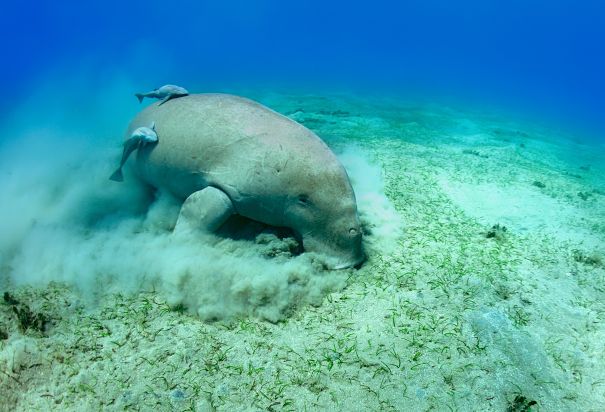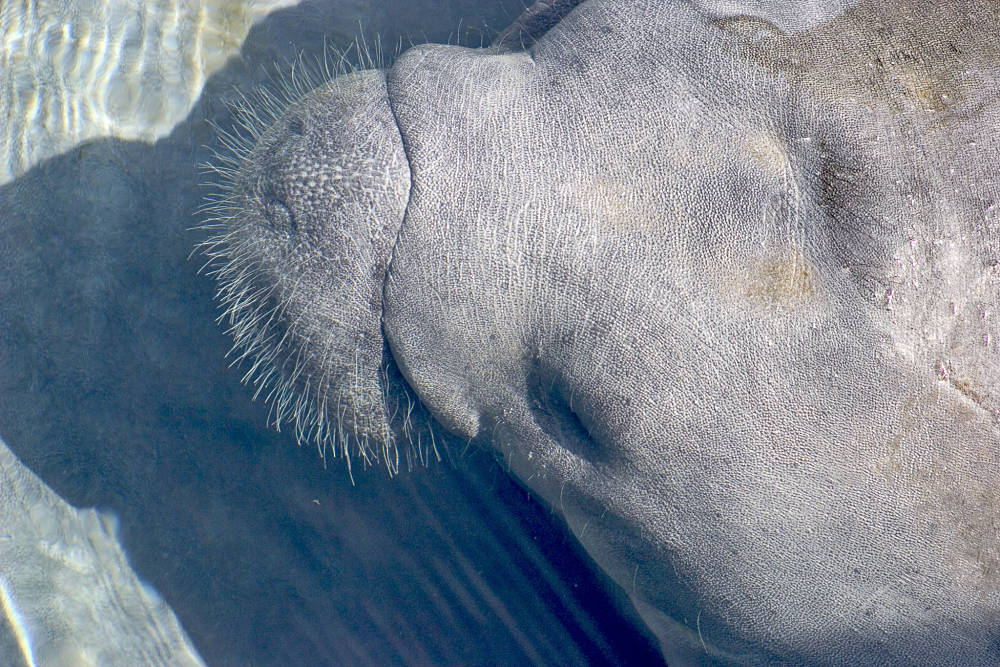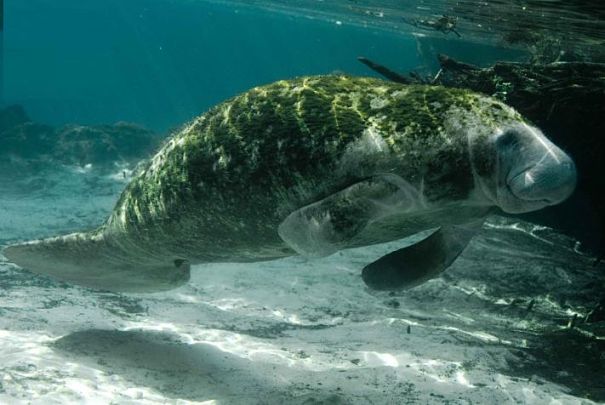Manatee Facts
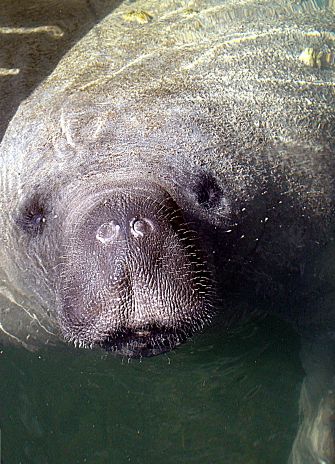 Portrait of a Manatee
Portrait of a Manatee
Undoubtedly the coolest of all manatee facts is that their seemingly hairless bodies are actually covered in thousands of short, whisker-like, "tactile hairs", that can help them "see" what's around them. Manatees and their cousin the dugong, are exceedingly gentle, peaceful beings, often referred to as "sea cows". There are three species of manatees, the West Indian, the West African, and the Amazonian, and one species of dugong, that make op the order "sirenia".
This word is taken from the story of the Sirens, who were mermaid-like creatures for which manatees have been mistaken by early explorers like Christopher Columbus! (more on that later..) Sirenians are all very similar in appearance, with smooth, rounded, massive bodies, flipper-like forelimbs, and a webbed tail. The West Indian Manatee is the largest species, averaging around 10 to 12 feet in total length, and weighing between 800 and 1200 pounds.
The West Indian manatee looks allot like a whale or a walrus, but is actually most closely related to the elephant,. Notice the flat toenails on each flipper, and the flexible, somewhat prehensile upper lip, that are reminiscent of elephant anatomy.
There are two subspecies of West Indian manatee, the Antillean manatee, and the Florida manatee.
Antillean manatees generally range down the coast of Mexico and South America, and can be found near the shorelines of Jamaica, Cuba and Haiti. Antillean manatees are sometimes called Caribbean manatees.
The Florida manatee lives along the South Eastern coast of North America, and has been found as far North as Cape Cod, although Georgia is more typically the peak of their range.
The West African manatee can be found in the coastal areas of West Africa. They look almost identical to the West Indian, but they have been barely studied, and not much is known about them.
Both the West Indian and the West African manatees can live in water with various degrees of salinity, from fresh, to brackish, to ocean.
Amazonian manatees are strictly a freshwater species found throughout the Amazon basin in countries like Brazil, Peru and Columbia. They are the smallest species, most easily recognized by a white or pinkish colored chest patch. They have smoother skin and lack nails on their flippers.
Manatees enjoy the warm, shallow waters of coastal marshes, rivers and estuaries. They are exclusively vegetarian, but may occasionally scarf in shellfish or other wildlife as they cruise for their favorite plants and algae.
The manatee is referred to as the "sea cow", since its life of munching on underwater greens and drifting from one watery pasture to the next, sometimes in large herds, might seem allot like a cow. They are the only marine mammals that live exclusively on vegetation, just like a cow, and this diet produces a great deal of gas, also like a cow.
Manatees are very flatulent, and the gasses that haven't escaped yet are held within their body cavity creating a great deal of buoyancy. To counteract this, the manatee has an incredibly dense skeleton, with marrow-less bones that allow it to sink to the bottom despite being a bit of a hot-air balloon.
They can remain submerged for a casual 5 or 6 minutes at a time, while using their flippers to walk along the bottom, or grazing mid-depth flora, using. When sleeping, the manatee can stay under for 20 minute stretches, bobbing just below the surface, or sinking deeper to rest on a sandy bed, and drifting up dreamily 3 or 4 times an hour to take a breath.
Manatee Lifestyle
Florida manatees are nomadic and non-territorial. They may come together in large herds in prime locations, or travel in pairs or groups to different feeding grounds or warmer waters, but they don't form close bonds, and they come and go as they please.
Although they look a little chunky, manatees don't have the layer of blubber that whales and seals utilize for warmth. They also have a slow metabolism, and very slow movements, so they don't warm up on their own. Warmth is important for survival, and they migrate to warmer waters seasonally, seeking minimum water temperatures of 70 degrees to protect them from disease. In fact, consistent temperatures below 68 degrees can be fatal to a manatee.
Their love for warm water which means manatees end up in allot of the places that people do. They may cruise various northern waterways from April to October, sometimes wandering as far as North Carolina or Maryland, but in the winter months, they migrate south to Florida's freshwater springs, where the water temperature is ideal at 72 degrees year-round.
They can also be observed in great numbers at sites like the Big Bend power plant, where discharge water creates a warm environment. The power company built an entire viewing center with observation stations to accommodate manatee lovers, and educate folks about these awesome creatures.
Manatees are quite friendly and curious about people too, and in Crystal River in Citrus County, Florida, tours are organized for people to swim and interact with them. This is the only place in Florida where people can legally swim with manatees, who are otherwise protected by both State and Federal law, and special areas are roped off so the manatees that want a little privacy can graze undisturbed.
Although many manatees appear to enjoy the interaction, and will actually gaze right in peoples eyes, there are fines handed out for anyone who actually touches one, and some concerns that the activity is impacting the animals well-being.
Manatees eat a wide variety of aquatic vegetation like shoal grass, water Hyacinth, mangrove leaves and a long, slender type of plant that's actually called manatee grass. They use their flippers to move sea grasses to their mouth, and their top lip, which is split into two prehensile halves, pulls the food in.
Generally, hair provides warmth and protection, but tactile hairs, known as vibrissae, have a completely different set of functions. The manatee has about 2,000 vibrissae on the face, and another 3,300 or so distributed sparsely over the body. Most other mammals have vibrissae only on the face, like the whiskers of dogs and cats. Some animals like raccoons have vibrissae on their paws and legs.
But the manatee is the only animal that has only vibrissae, and no other type of hair, not even eyelashes.
The tactile hairs on the face of the manatee, located in a circular region surrounding the mouth known as the oral disk, are said to be as sensitive as fingertips. They are used as we use our hands, to explore the environment and gather information on food, objects and other manatees.
The tactile hairs covering the body are believed to help manatees monitor changes in water currents, and may detect energy reflected off objects as the manatee navigates through murky water, allowing them to understand the size and location of things in the environment, somewhat like echolocation.
Manatees communicate with eachother through squeaks and squeals, and there is lots of chatter between mother and calf.
The manatee has a very small brain for its body size, and the brain is unusually smooth, without all the ridges seen in most mammals brain surfaces, but recent studies suggest they are rather intelligent and can perform some discrimination tasks with the same aptitude as seals and dolphins. Based on these findings, it has been suggested that maybe a manatee has a very big body, as opposed to a very small brain.
Manatee Facts On Reproduction
Manatees don't have a set breeding season, and females may come into estrous at any time of year. When they do, they attract numerous males - sometimes as many as twenty - and create what is known as a manatee mating herd.
This excited group may stay with the female for the length of her estrous, which may be up to 3 weeks. She will mate with numerous males at this time. Dugongs differ from manatees in that they form a pair, and are monogamous.
The female is pregnant for 12 to 13 months and gives birth to a calf that is about 4 feet long, and 55 to 70 pounds. The baby may be born either head or tail first, and the mother guides the newborn to the surface to take its first breath. The baby can swim immediately, and begins to vocalize within a few minutes.
Baby and mother manatees communicate continually with squeaks, clicks, moans and whistles. Babies have been seen on their mothers backs, but they usually travel next to her, and directly behind the flipper, which may allow them to "draft" in her current.
The baby manatee nurses from two nipples located behind each flipper, and usually continues to nurse for about a year. The baby is born with all its teeth, and begins to sample plants at about one week old.
Adult manatees are not usually threatened by predators, but babies can fall victim to alligators and sharks, and the Amazonian manatee has been known to be the prey of jaguars. Mothers may try to intervene, but they are slow and have little offense.
Youngsters stay with their mothers for about 2 years, learning migration paths, best feeding spots and the ins and outs of waterways. Since the manatees tend to be nomadic, with no actual territory, there is allot to be taught.
The reproduction rate of manatees is very slow. They are not mature enough to mate for several years, they give birth to one offspring at a time, and they spend 2 years raising the calf. This makes their status as a vulnerable or endangered species even more perilous.
Are Manatees Mermaids?
One of the more confusing manatee facts, is that they appear in the journals of some very famous people, who describe them as mermaids.
Captain John Smith mentions them, and Henry Hudson too. And none other than Christopher Columbus, who is referenced by a shipmate -
"On the previous day, when the Admiral went to the Rio del Oro [Haiti], he said he quite distinctly saw three mermaids, which rose well out of the sea; but they are not so beautiful as they are said to be, for their faces had some masculine traits." (Voyages of Columbus 218)."
This is considered to be the first written record of the manatee in North America.
There is no doubt that if they come up out of the water and the light is just so, it could definitely look like the head of a person, and it is also possible that the location of the nipples, on the chest like human beings, added to the presumption.
Skeletal remains of manatees might look somewhat human as well, with the forelimbs revealing five distinct fingers once the flipper webbing is gone.
And don't forget, dugong loosely translated means "lady of the sea" in the Malaysian language.
The fact that the manatees scientific name - sirenia - comes directly from the Sirens of Greek mythology, who lured sailors with their beautiful songs, implies that more than one sea-going fella saw them in this light...just the right light.
What's The Difference Between Dugongs And Manatees?
The dugong and the manatees exist together in their own taxonomic order known as the Sirenians, but they are split into two different families. There are numerous differences both physically and behaviorally.
The dugong is found in the Pacific Ocean along the coasts of East Africa, South Asia and Australia. They live exclusively in saltwater, and are the only living species in the family dugongidae. Its close relative, the now extinct Stellars sea cow, was discovered by German explorer and naturalist Georg Wilhelm Steller in 1741.
These amazing animals had tiny heads and enormous 30 foot long bodies. They were probably responsible for some of the mermaid stories, because they were said to bask partially on shore. Less than 30 years after Stellar discovered the fantastic sea cow, it was hunted out of existence.
Dugongs only grow to about 8 feet long, weighing about 650 pounds. They have a crescent shape tail, like a whale, and the upper lip is not divided as it is in the manatee.
The muzzle of the dugong has a steeper angle, and the eyes are higher up on the head.
Dugongs are more solitary, living alone or in pairs. It is thought that they might mate for life.
A major difference that puts dugongs at greater risk than manatees is that dugongs do not reach sexual maturity until they are about 10 years old, making their reproductive rate even slower the manatee.
A Few More Manatee Facts
- Christopher Columbus mistook a manatee for a mermaid
- Manatees may have the smallest brain-to-body ratio of any mammal
- When sleeping, manatees only need to take 3 breaths an hour
- Algae often grows on the backs of manatees - and acts as a sunscreen
- Manatees have thousands of whisker-like hairs all over their bodies
- The elephant is the closest relative of the manatee
- Manatees use their flippers to walk along the river bottom
- Manatees replace their molars as they where down
- Despite how it may appear, the manatee does not have a layer of blubber and can't stand the cold
